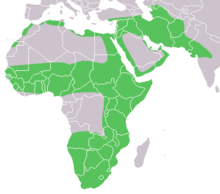Caracal caracal
| Caracal | |
|---|---|
 |
|
| Scientific classification | |
| Kingdom: | Animalia |
| Phylum: | Chordata |
| Class: | Mammalia |
| Order: | Carnivora |
| Family: | Felidae |
| Subfamily: | Felinae |
| Genus: |
Caracal Gray, 1843 |
| Species: | C. caracal |
| Binomial name | |
|
Caracal caracal (Schreber, 1776) |
|
| Subspecies | |
|
See text |
|
 |
|
| Caracal distribution | |
| Synonyms | |
|
List
|
|
See text
The caracal (Caracal caracal) (pronounced /ˈkærəkæl/) is a medium-sized wild cat native to Africa, the Middle East, Central Asia and India. It is listed as Least Concern on the IUCN Red List and threatened by anthropogenic mortality and habitat loss due to conversion of natural habitat for agricultural land and settlements. Its natural habitat includes semi-deserts, open savannas, shrublands, moist woodlands and montane forests. The caracal is characterised by a robust build, long legs, a short face, long tufted ears and long canine teeth. Its coat is uniformly reddish tan or sandy, while the ventral parts are lighter with small reddish markings. It reaches 40–50 cm (16–20 in) at the shoulder and weighs 8–18 kg (18–40 lb). It was first described by German naturalist Johann Christian Daniel von Schreber in 1777. Eight subspecies are recognised.
Typically nocturnal, the caracal is highly secretive and difficult to observe. It is territorial, and lives mainly alone or in pairs. The caracal is a carnivore that typically preys upon small mammals, birds and rodents. It can leap higher than 3 m (9.8 ft) and catch birds in mid-air. It stalks its prey until it is within 5 m (16 ft) of it, after which it runs it down, the prey being killed by a bite to the throat or to the back of the neck. Breeding takes place throughout the year with both sexes becoming sexually mature by the time they are a year old. Gestation lasts between two and three months, resulting in a litter of one to six kittens. Juveniles leave their mothers at nine to ten months, though a few females stay back with their mothers. The average lifespan of the caracal in captivity is nearly 16 years.
...
Wikipedia

